Physostome on:
[Wikipedia]
[Google]
[Amazon]
 Physostomes are fishes that have a pneumatic duct connecting the
Physostomes are fishes that have a pneumatic duct connecting the
 Physostomes are fishes that have a pneumatic duct connecting the
Physostomes are fishes that have a pneumatic duct connecting the gas bladder
The swim bladder, gas bladder, fish maw, or air bladder is an internal gas-filled organ that contributes to the ability of many bony fish (but not cartilaginous fish) to control their buoyancy, and thus to stay at their current water depth wit ...
to the alimentary canal
The gastrointestinal tract (GI tract, digestive tract, alimentary canal) is the tract or passageway of the digestive system that leads from the mouth to the anus. The GI tract contains all the major organs of the digestive system, in humans and ...
. This allows the gas bladder to be filled or emptied via the mouth. This not only allows the fish to fill their bladder by gulping air, but also to rapidly ascend in the water without the bladder expanding to bursting point. In contrast, fish without any connection to their gas bladder are called physoclisti Physoclisti are, collectively, fishes that lack a connection between the gas bladder and the alimentary canal, with the bladder serving only as a buoyancy
Buoyancy (), or upthrust, is an upward force exerted by a fluid that opposes the w ...
.
The physostome fish encompass the bichirs, gars, a number of carp
Carp are various species of oily freshwater fish from the family Cyprinidae, a very large group of fish native to Europe and Asia. While carp is consumed in many parts of the world, they are generally considered an invasive species in parts of ...
s, trout
Trout are species of freshwater fish belonging to the genera '' Oncorhynchus'', '' Salmo'' and '' Salvelinus'', all of the subfamily Salmoninae of the family Salmonidae. The word ''trout'' is also used as part of the name of some non-salm ...
s, herrings, catfish
Catfish (or catfishes; order Siluriformes or Nematognathi) are a diverse group of ray-finned fish. Named for their prominent barbels, which resemble a cat's whiskers, catfish range in size and behavior from the three largest species alive, ...
, eels and the lungfish
Lungfish are freshwater vertebrates belonging to the order Dipnoi. Lungfish are best known for retaining ancestral characteristics within the Osteichthyes, including the ability to breathe air, and ancestral structures within Sarcopterygii, i ...
. While the gas bladder in fish mainly serves as a buoyancy
Buoyancy (), or upthrust, is an upward force exerted by a fluid that opposes the weight of a partially or fully immersed object. In a column of fluid, pressure increases with depth as a result of the weight of the overlying fluid. Thus the ...
organ, some physostomes (though not all) can use their gas bladder as a lung
The lungs are the primary organs of the respiratory system in humans and most other animals, including some snails and a small number of fish. In mammals and most other vertebrates, two lungs are located near the backbone on either side of ...
, allowing them to live from atmospheric oxygen in conditions where aquatic oxygen levels have dropped to a point which would kill other fish.
References
*External links
* {{diversity of fish Fish anatomy